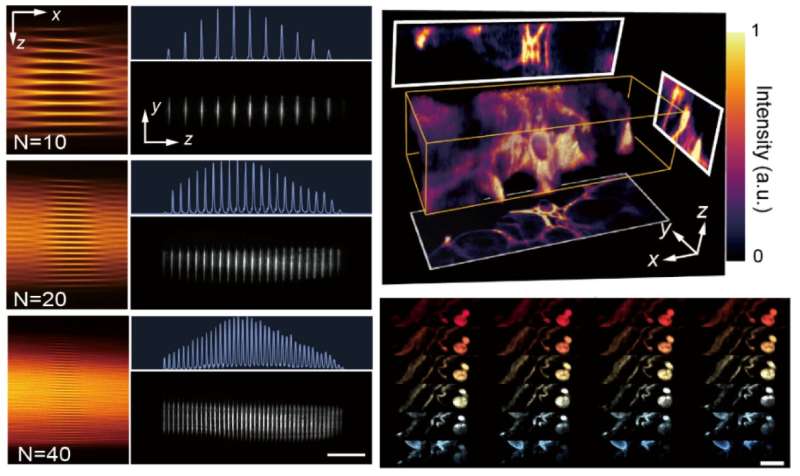Light-sheet fluorescence imaging becomes more parallelized

An arsenal of advanced microscopy tools is now available to provide high-quality visualization of cells and organisms in 3-D and has thus substantiated our understanding the complex biological systems and functions.
In a new paper published in Light: Science & Applications, a research team led by the University of Hong Kong (HKU) developed a new form of imaging modality, coined coded light-sheet array microscopy (CLAM) that allows full 3-D parallelized fluorescence imaging without any scanning mechanism—a capability that is otherwise challenging in the existing techniques.
Established 3-D biological microscopy techniques, notably confocal, multiphoton microscopy, and light-sheet fluorescence microscopy (LSFM), predominantly rely on laser-scanning for image capture. Yet, it comes at the expense of imaging speed because the entire volume has to be sequentially scanned point-by-point, line-by-line or plane-by-plane at a speed limited by the mechanical motions involving the imaging parts.
Even worse, many serial scanning approaches repeatedly excite out-of-focus fluorescence, and thus accelerate photobleaching and photodamage. They are thus not favorable for long-term, large-scale volumetric imaging critically required in applications as diverse as anatomical science, developmental biology and neuroscience.
3-D parallelization in CLAM requires even gentler illumination to achieve a similar level of image sensitivity at the same volumetric frame rate. Hence, it further reduces the photobleaching rate and thus the risk of photodamage. This is a critical attribute for preserving the biological specimen viability in long term monitoring studies.
The heart of CLAM is the concept of the 'infinity mirror" (i.e., a pair of parallel mirrors), which is common in visual art and decoration, and has previously been adopted by the same team for enabling ultrafast optofluidic single-cell imaging. Here the team employed the 'infinity mirror" together with simple beam shaping to transform a single laser beam into a high-density array of few tens of light-sheets for 3-D parallelized fluorescence excitation.
"One distinct feature of CLAM is its ability to flexibly reconfigure the spatial density and temporal coherence of the light sheet array, simply by tuning the mirror geometry, such as mirror separation and tilt angle," explained Dr. Yuxuan Ren, the postdoctoral researcher and the first author of the work.
"This capability has been challenging in the existing coherent wavefront shaping methods, yet could allow efficient parallelized 3-D LSFM in scattered tissue imaging with minimal speckle artifact," Ren added.
CLAM also adopts code division multiplexing (CDM) (e.g., orthogonal frequency division multiplexing demonstrated in this work), a technique widely used in telecommunication, to imprint the fluorescence signal from each image plane with a unique code. As a result, it allows parallelized 3-D image capture with optical sectioning by using a 2-D image sensor.
"CLAM has no fundamental limitation in scaling to higher volume rate as camera technology continually advances," Dr. Kevin Tsia, Associate Professor in Department of Electrical and Electronic Engineering at HKU and the leading researcher of the team pointed out.
"Also, CLAM can be adapted to any existing LSFM systems with minimal hardware or software modification. Therefore, it is readily available for dissemination to the wider community of LSFM and related 3-D imaging techniques," added Tsia.
More information: Yu-Xuan Ren et al, Parallelized volumetric fluorescence microscopy with a reconfigurable coded incoherent light-sheet array, Light: Science & Applications (2020). DOI: 10.1038/s41377-020-0245-8
Journal information: Light: Science & Applications
Provided by Chinese Academy of Sciences


















